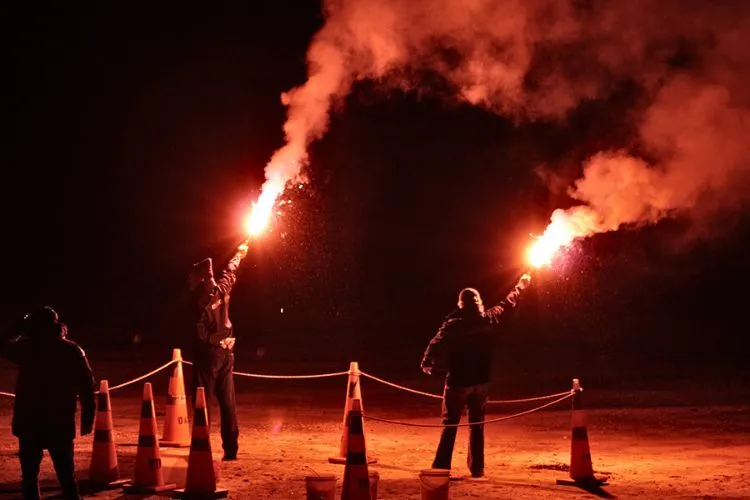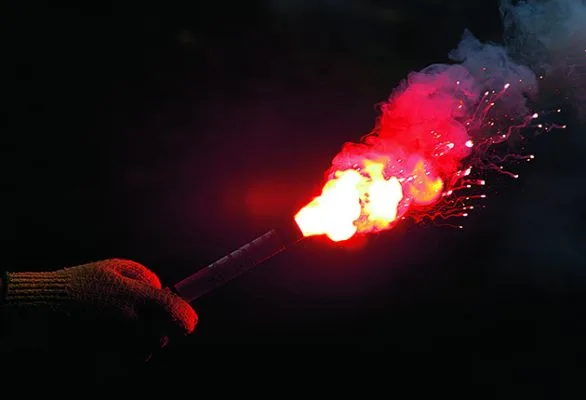Flares serve as crucial tools in various emergency and signaling scenarios. Understanding how to extinguish a flare safely is essential for preventing harm and ensuring proper usage.
This article explores the nuances of handling different types of flares, emphasizes safety precautions, and provides practical advice for dealing with these pyrotechnics.

Types of Flares
Flares fall into two main categories: pyrotechnic and non-pyrotechnic. Pyrotechnic flares produce bright light or intense heat through a chemical reaction.
They are common in maritime, aviation, and roadside emergencies for signaling distress or illuminating areas. These flares burn with an open flame and require specific methods to extinguish safely.
Non-pyrotechnic flares, such as LED flares, offer a modern alternative. They provide many advantages, including being reusable, easier to extinguish, and safer to store and handle.

LED flares emit light without generating heat, making them a preferred choice in situations where fire risks are a concern.
Safety Precautions
Before attempting to extinguish a flare, one must don proper protective equipment. Gloves and safety glasses protect against burns and eye injuries.
Always read the manufacturer’s instructions carefully; these guidelines offer crucial information specific to the flare in use.
How to Extinguish a Flare?
Extinguishing Pyrotechnic Flares
When dealing with a pyrotechnic flare, allow it to burn down as much as safely possible. This approach minimizes the amount of material you need to extinguish. If applicable, gently apply water to cool the flare.
However, do this with caution. Introducing water too quickly or in large amounts can create steam and scatter hot materials.
Once the flare ceases to burn, dispose of it according to local regulations, ensuring it’s completely cooled before disposal.
It’s vital to avoid smothering the flare in an attempt to extinguish it, as this can cause the flare to become dangerously hot or erupt unexpectedly. Ensure that the area is well-ventilated to avoid inhalation of toxic fumes.
Deactivating Non-pyrotechnic (LED) Flares
LED flares are more straightforward to handle. Simply turn off the device or remove its power source (typically batteries).
Since these flares don’t use open flames or heat, they pose less risk during deactivation. However, proper disposal or recycling of batteries is key to environmental safety.
Pro Tips
Store flares in a dry, cool location to ensure their longevity and reliability. Check flares regularly for signs of damage or expiration.
If a flare seems compromised, it’s safer to dispose of it properly rather than attempt to use it. Always adhere to local laws regarding flare storage, usage, and disposal to avoid legal issues.
Environmental Considerations
The use and disposal of flares have significant environmental implications. Pyrotechnic flares, which contain potentially toxic substances and metals, can pollute both terrestrial and marine environments if not disposed of properly. They can harm wildlife, contaminate water sources, and contribute to soil degradation.

Therefore, embracing eco-friendly disposal methods is crucial. Many regions offer hazardous waste collection programs specifically designed for items like flares. Additionally, opting for non-pyrotechnic alternatives, such as LED flares, significantly reduces environmental impact.
These reusable options eliminate the risks associated with chemical residue and unburned material, offering a more sustainable choice for signaling during emergencies.
Legal Implications of Flare Use
Navigating the legal terrain surrounding flare usage is pivotal to avoid potential fines or penalties. Regulations vary widely by jurisdiction but typically encompass guidelines on transportation, storage, usage, and disposal.

Unauthorized or improper use of flares, especially in non-emergency situations, can lead to legal repercussions, including substantial fines or even criminal charges. For example, intentionally causing false alarms or environmental damage with flares can attract severe penalties.
Furthermore, improper disposal, particularly of pyrotechnic flares, might infringe on environmental protection laws, leading to fines and sanctions.
Adhering to local and federal laws, therefore, ensures not just compliance but also promotes safety and environmental stewardship.
Case Studies
Learning from both successful and mishandled flare usage is invaluable. Consider the story of a small fishing vessel whose crew safely signaled a passing ship with a flare during a power failure, ultimately leading to their rescue.
Conversely, there’s the harrowing case of improper flare disposal causing a forest fire, underscoring the critical need for caution.
Such incidents highlight the fine line between flares as lifesaving tools and potential hazards, emphasizing the importance of proper handling and awareness of local conditions.
Frequently Asked Questions (FAQs)
Are there any flares that cannot be extinguished once ignited?
Some pyrotechnic flares are designed to burn completely once activated and cannot be safely extinguished. In these cases, ensure the flare burns in a safe area away from people or flammable materials.
How long does a typical pyrotechnic road flare burn?
Most pyrotechnic flares burn for about 15 to 60 minutes. Factors such as the flare’s composition and environmental conditions can affect the burn time.
Can water be used to extinguish all types of flares?
Water can cool some pyrotechnic flares but is not universally effective. Always refer to the flare’s instructions to ensure safe extinguishing practices.
How should flares be stored to ensure their longevity and reliability?
Keep flares in a dry, cool place out of direct sunlight. This environment helps preserve the flares’ integrity and readiness for use.
Is it legal to carry flares in a vehicle at all times?
Laws vary by region, but carrying flares in vehicles, especially for emergency purposes, is legal in many areas. Verify local regulations to ensure compliance.
Conclusion:
Knowing how to extinguish a flare properly is crucial for safety in emergency situations. By following the guidelines and safety precautions outlined above, individuals can handle flares responsibly.
Remember, the priority is always to prevent injury and manage the flare in a way that avoids risk to yourself and others.


